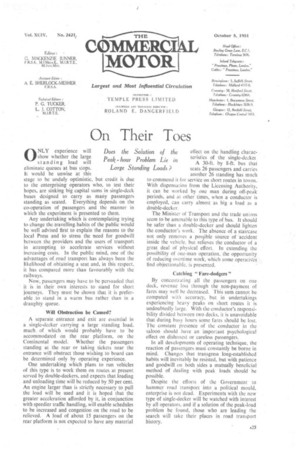On Their Toes
Page 27

If you've noticed an error in this article please click here to report it so we can fix it.
ONLY experience will show whether the large standing load will eliminate queues at bus stops. It would be unwise at this stage to be unduly optimistic, but credit is due to the enterprising operators who, to test their hopes, are sinking big capital sums in single-deck buses designed to carry as many passengers standing as seated. Everything depends on the co-operation of passengers and the manner in which the experiment is presented to them.
Any undertaking which is contemplating trying to change the travelling, habits of the public would be well advised first to explain the reasons to the local Press and to stress the 'need for goodwill between the providers and the users of transport in attempting to accelerate services without increasing costs. In the public mind, one of the advantages of.!pad transport has always been the likelihood of obtaining a seat and, in this respect, it has compared more than favourably with the railways.
Now, passengers may have to be persuaded that it is in their own interests to stand for short journeys. They must be shown that it is preferable to stand in a warm bus rather than in a draughty queue. .
Will Obstruction be Caused?
A separate. entrance and exit are essential in a single-decker carrying a large standing load, much of which would probably have to 'be accommodated on the rear platform, on the Continental model. Whether the passengers standing at •the rear or taking tickets near the entrance will obstruct those wishing to board can be determined only by operating experience.
One undertaking which plans to run vehicles of this type is to work them on routes at present served by double-deckers, and expects that loading and unloading time will be reduced by 50 per cent. An engine larger than is strictly necessary to pull the load will be used and it is hoped that the greater acceleration afforded by it, in conjunction with speedier traffic handling, will enable schedules to be increased and congestion on the road to be relieved. A load of about 15 passengers on the rear platform is not expected to have any material effect on the handling characteristics of the single-decker A 30-ft. by 8-ft. bus that seats 26 passengers and carries another 26 standing has much to commend it for service on short routes in towns. With dispensation from the Licensing Authority, it can be worked by one man during off-peak ,periods, and at other tirries, when a conductor is employed, can carry almost as big a load as a double-decker.
The Minister of Transport and the trade unions seem to be amenable to this type of bust It should be safer than a double-decker and should lighten the conductor's work. The absence of a staircase not only removes a possible Source of accident inside the vehicle, but relieves the conductor of a great deal of physical effort. In extending the possibility of one-man operation, the opportunity of reducing overtime work, which some operatiVes find objectionable, is presented: Catching " Fare-dodgers " By concentrating all the passengers on one deck, revenue lost through the non-payment of fares may well he decreased. This sum cannot be computed with accuracy, but in undertakings experiencing heavy peaks on short routes it is undoubtedly large. With the conductor's responsibility divided between two decks, it is unavoidable that during busy hours some fares should be lost. The constant presence of the conductor in the saloon should have an important psychological effect on dishonest or careless passengers.
In all developments of operating technique, the reaction of passengers must constantly be borne in mind. Changes that transgress long-established habits will inevitably be resisted, but with patience and goodwill on both sides a mutually beneficial method of dealing with peak loads should be possible.
Despite the efforts of the Government to hammer road transport into a political mould, enterprise is not dead. Experiments with the new type of single-decker will be watched with interest by all operators, and if a solution of the peak-load problem be found, those who are leading the search will take their places in road transport history.
































































































